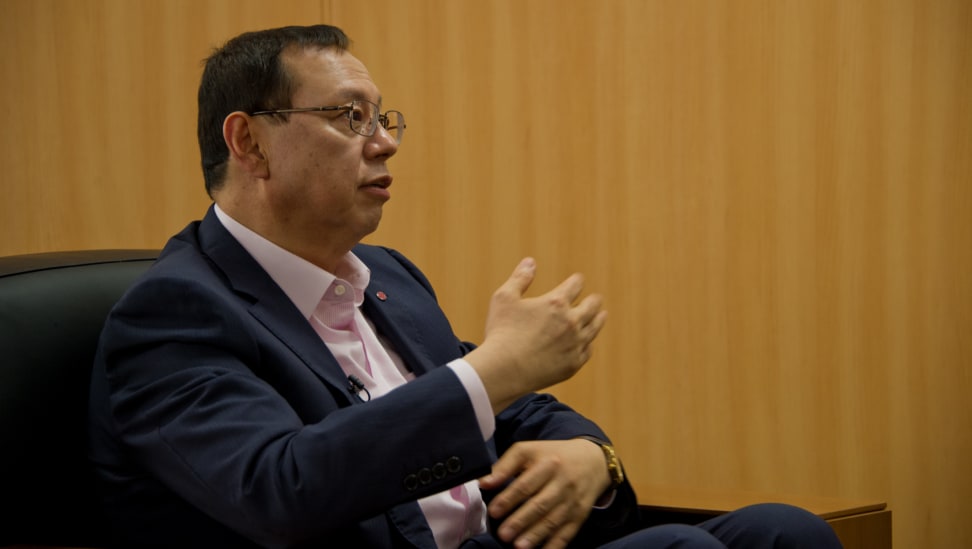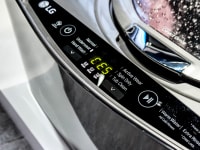Meet Mr. Washing Machine, the new CEO of LG Electronics
Seong-Jin Jo redefined the washing machine. Now he's running LG Electronics.
 Credit:
LG Electronics
Credit:
LG Electronics
Recommendations are independently chosen by Reviewed's editors. Purchases made through the links below may earn us and our publishing partners a commission.
Last week, Korea-based LG Electronics appointed Seong-Jin Jo as its CEO. Previously in charge of the company’s home appliance division, Jo will now oversee everything from TVs and laptops to smartphones and vehicle components.
However, the 60-year-old executive’s rise to head one of the best-known brands in the world has been far from meteoric. Instead, it follows a 40-year career that largely unfolded behind the scenes. During that time, Jo has been instrumental in growing the LG home appliance brand, largely through dedication to laundry appliances—a devotion that earned him the nickname “Mr. Washing Machine.”

LG Twin Towers in Seoul.
When Jo ran LG’s home appliance business, he was responsible for a division that did more than $15 billion in revenue worldwide in 2015. As CEO of LG Electronics, he’ll be in charge of a company more than three times that size—and with a far more diverse lineup of products. Faced with sluggish smartphone sales and shrinking profits across the TV industry, Jo’s mandate is to apply the lessons he learned while building the appliance business to the company’s other endeavors.
Reviewed.com got the chance to sit down with Jo over the summer at his office on the eighth floor of LG Twin Towers—the massive, matching buildings that house LG Electronics’ headquarters in Seoul, South Korea. In his first ever interview with the U.S. media, Jo spoke about his career, the product development process, and his advice for corporate growth.
Humble beginnings

LG Electronics' massive home appliance factory sits in the industrial city of Changwon.
Jo's start with LG was far from auspicious. In 1976, Jo had just graduated from high school when he got a job with a company called Goldstar. It was based in the southern city of Busan, so he moved from Seoul and started work.
“When you newly join a company, you’re assigned a role or a job,” he said. “All the other people had taken the good positions, so I went into the position that was left—which was washing machine development.”
It was the right place to be. According to Jo, only one tenth of one percent of Koreans owned a washing machine at that time, though that number would soon grow. At the same time, leaders in the manufacturing sector were beginning to think about exports.
But Goldstar only made cheap washers based on Japanese designs, and there was no way they could compete on the international stage. So Jo kept working, and new products kept coming. “Ten years down the road, twenty years down the road, I came to accept the washing machine as my destiny,” he said.

Seong-Jin Jo, explaining his passion for washing machines.
Over the years, Goldstar moved its headquarters to Seoul and changed its name to LG. Jo—who never attended college—remained with LG, rising through the company’s ranks. His team weaned itself off Japanese designs, benchmarked the competition, and developed some lofty ambitions for LG appliances.
“We set the goal of becoming number one for washing machines in the 1990s,” he said. “When we were ranking fifth and sixth in the market, we still set the vision of ranking number one, even when the company itself was more focused on other products like TVs.”
PHOTO GALLERY: LG's factory in Changwon, Korea
{{ photo_gallery name="Changwon Factory" }}
Eventually, Jo set his sights on the US market—long dominated by domestic players who understood the unique demands of American consumers. LG only started selling large appliances in the U.S. in 2003, but Jo said LG’s rapid growth in the U.S. is precisely because the company waited and did its homework.
“For a couple of years before that, we observed the market,” he said. For instance, Jo’s team noticed that the U.S. had a long history of top-load washing machines. But Jo had seen Korea, Australia, China, and Japan switch from top-load to front-load, and had reason to believe that America was next. So LG introduced front-load machines, adding features like steam and multi-colored finishes to further stand out from the competition.

LG's R&D center in Seocho District, Seoul.
Today, LG is the market leader in front-load laundry. That success has led to growth in other categories, and it’s now possible to outfit your whole home with an entire suite of LG appliances. New products—like the tech-focused LG Signature sub-brand and the upscale, built-in Signature Kitchen Suite—helped drive a year-to-date sales growth of 3.9 percent in 2016.
Scandal
For his efforts, the Korean government awarded Jo the Bronze Tower Order of Industrial Service Merit in 2007. But Jo didn’t make international headlines until he got caught up in one of the most bizarre events to ever occur in the normally sedate home appliance industry.
Back in September of 2014, LG was exhibiting at a major trade show in Berlin when Jo and a team of fellow LG employees visited a local department store to check out the competition’s products.

Seong-Jin Jo in his 8th floor office.
In an apparent effort to examine the strength of its hinges, Jo pushed on the door of a Samsung washing machine. The hinges broke, and a Samsung employee who witnessed the event called the police. In total, three machines at two stores ended up with broken hinges.
LG paid to repair the damage and admitted that hinges broke on the machine Jo handled, but Samsung wouldn’t back down, demanding that Jo be held accountable for what it called an act of sabotage. Samsung even flew the damaged washer back to Korea for examination—Exhibit A in the spin cycle of the century.

LG eventually released CCTV footage of Jo handling the Samsung machine.
In a press release, LG called out the absurdity of the situation. “If our company had an intention to destroy products of a certain company to tarnish the image of the product, it would be common sense to not have our executives directly carry out such acts," an LG representative wrote.
Still, Jo and two other LG execs were indicted. There was talk that Jo would be barred from leaving the country, and public prosecutors raided LG’s offices in Seoul and Changwon. Jo even faced a 10-month jail sentence—all stemming from an act of vandalism that, as it turns out, didn’t actually happen the way it was portrayed.
Eventually, LG released surveillance camera footage of the moment the door’s hinges gave way. Set to dramatic music with a Hard Copy visual aesthetic, it proved there had been no roughhousing. This summer, an appeals court put an end to any threat of punishment for Jo, and the case was officially behind him.
Shortly after the case was dismissed, LG spokesman Ken Hong called the whole event a “distraction,” adding that LG always maintained the charges had no merit. “In the end, we're just glad the court agreed with us,” he told Reviewed.com.
Research and Development
With the case of the broken washer officially closed, Jo would much rather talk about TwinWash—a unique appliance that puts a smaller washing machine underneath a larger one so consumers can wash two loads at the same time on different cycles. The product hit the market in 2015, but only came about after a decade of trial and error.

A press handout shows LG's TwinWash in use.
Initially, Jo wanted to combine the benefits of an easy-to-load top-load washer and the energy efficiency of a front-load washer. So he assembled a confidential team—a laundry skunkworks—devoted solely to making his dream a reality. How the project evolved during its decade-long development process offers some clues to Jo’s leadership and management style.
“It’s difficult to say that TwinWash was the outcome of this project that started a long time ago,” he said. “The results we got were actually quite different from the results we intended to get in the beginning.”

The LG Signature lineup includes a refrigerator, air purifier, TV, and washing machines.
The first attempt—a washing machine that tilted on its side after you finished loading it—was a total failure: The mechanicals were too complicated and it did a terrible job cleaning clothes.
“There were thousands of design renderings and trials and research about the related mechanisms that continued for two or three years,” Jo said. Things weren’t looking good. Then, a flash of inspiration struck. “A friend and I thought of this idea of cutting the washing machine in half, where we’d have the front loader at the top and the top loader beneath,” he said.

A worker assembles an LG TwinWash machine.
While the prototype cleaned clothes, one major problem still remained: Joining two machines that spin at different frequencies can cause a phenomenon known as resonance—which has baffled engineers for centuries. Resonance is what caused the Tacoma Narrows Bridge to collapse and the Lockheed Electra airplane to fall out of the sky.
In the case of TwinWash, vibrations from the bottom unit would amplify those up top, and the whole apparatus would start to move on its own, as if someone was crudely wrangling it across the room. In the world of washing machines, that’s called “walking.”
“I went for lunch during a test, and when I came back the washing machine had fallen over,” Jo said. “We had made a walking machine, not a washing machine.”

Inside the lobby of LG Twin Towers.
But Jo and his team of engineers and designers just kept working. When TwinWash finally hit the market in the middle of 2015, it looked nothing like Jo’s original idea—but it also looked nothing like anything else on the market.
“In some ways, we worked the process the other way around to come up with a completely new product,” he said.
Work to do
Back in July, Jo attributed LG’s growth in the home appliance industry to its focus on innovation—especially when it helped solve the problems consumers had with essentials like food, clothing, and shelter. As CEO of the whole of LG Electronics, however, Jo will have to bring innovation to entertainment, communication, and mobility—all categories with far shorter development cycles than washers and dryers.

LG Twin Towers, Seoul
He’s also taking charge of a company whose divisions enjoy varying degrees of success: While home appliance has seen steady growth, sales of LG smartphones have fallen—largely due to lackluster interest in the company's flagship model. TV revenues are solid thanks to advanced technology like OLED, but competition from Chinese manufacturers and tight margins are threats to future success. There’s also a nascent automotive business—LG worked closely with GM to build the Chevrolet Bolt electric car.
Still, as recently as July, Jo seemed confident about LG’s future.
“When there’s something that must be done and needs to be improved, we’re the only ones that will do so,” he said. “So I think that’s what has helped us succeed.”



